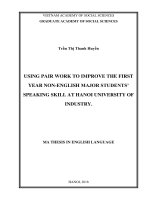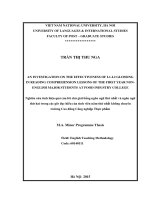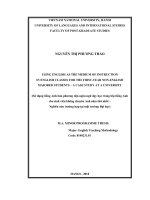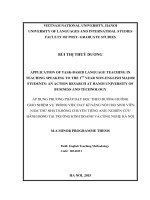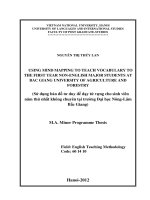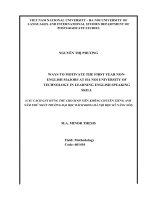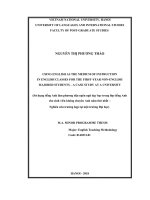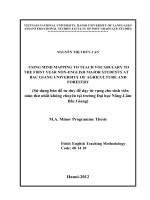Using english as the medium of instruction in english classes for the first year non english majored students – a case study at a university
Bạn đang xem bản rút gọn của tài liệu. Xem và tải ngay bản đầy đủ của tài liệu tại đây (664.7 KB, 83 trang )
VIETNAM NATIONAL UNIVERSITY, HANOI
UNIVERSITY OF LANGUAGES AND INTERNATIONAL STUDIES
FACULTY OF POST-GRADUATE STUDIES
NGUYỄN THỊ PHƯƠNG THẢO
USING ENGLISH AS THE MEDIUM OF INSTRUCTION
IN ENGLISH CLASSES FOR THE FIRST-YEAR NON-ENGLISH
MAJORED STUDENTS – A CASE STUDY AT A UNIVERSITY
(Sử dụng tiếng Anh làm phương tiện ngôn ngữ dạy học trong lớp tiếng Anh
cho sinh viên không chuyên Anh năm thứ nhất –
Nghiên cứu trường hợp tại một trường Đại học)
M.A. MINOR PROGRAMME THESIS
Major: English Teaching Methodology
Code: 8140231.01
HANOI - 2018
VIETNAM NATIONAL UNIVERSITY, HANOI
UNIVERSITY OF LANGUAGES AND INTERNATIONAL STUDIES
FACULTY OF POST-GRADUATE STUDIES
NGUYỄN THỊ PHƯƠNG THẢO
USING ENGLISH AS THE MEDIUM OF INSTRUCTION
IN ENGLISH CLASSES FOR THE FIRST-YEAR NON-ENGLISH
MAJORED STUDENTS – A CASE STUDY AT A UNIVERSITY
(Sử dụng tiếng Anh làm phương tiện ngôn ngữ dạy học trong lớp tiếng Anh
cho sinh viên không chuyên Anh năm thứ nhất –
Nghiên cứu trường hợp tại một trường Đại học)
M.A. MINOR PROGRAMME THESIS
Major: English Teaching Methodology
Code: 8140231.01
Supervisor: Dr. Nguyễn Thị Mai Hương
Nguyễn Thị Mai Hương
HANOI - 2018
STATEMENT OF AUTHORITY
I hereby state that the Master’s thesis entitled “Using English as the medium of
instruction in English classes for the first-year non-English majored students – A
case study at a university” was carried out by me for the degree of Master of English
Teaching Methodology under the guidance and supervision of Dr. Nguyễn Thị Mai
Hương. Where I have quoted from the work of others, the sources are always given.
With the exception of such quotations, this thesis is entirely on my own work. I confirm
that the work has not be submitted for any other degree or professional qualification.
I agree that the origin of my paper deposited in the library should be accessible
for the purposes of study and research, in accordance with the normal conditions
established by the librarian for the care, loan or reproduction of the paper.
Signature
Nguyễn Thị Phương Thảo
Hanoi, …………………….20….
i
ACKNOWLEDGMENTS
On the completion of this paper, I wish to express my gratitude to my
teachers, teacher- and student-participants, friends and family.
First of all, I would like to express my deepest gratefulness to my supervisor.
Her intellectual consultancy, valuable comments and spiritual encouragement were
an indispensable factor in the fulfillment of this research.
I was also obliged to the teachers at the Faculty of Post-graduate Studies of
University of Languages and International studies for their precious lessons. They
provided me with understandings and skills relating to English language teaching,
which supported much for the completion of this study particularly and my career
generally.
Furthermore, I sincerely appreciate the cooperation of the teacher- and
student-participants. I would like to thank Teacher A and Teacher B for their
willingness to let me observe their EFL classes and enthusiastic participation in my
interviews. I am also thankful to 93 students of the two A2 classes for agreeing to
participate in the survey. They are the ones who directly influenced the results of
this study.
Last but not least, I am also indebted to my beloved family, who has
constantly supported me since I started participating in the Master programme, and
my friends, who have always encouraged me and gave me valuable suggestions.
ii
ABSTRACT
In the context of Vietnam, Vietnamese is still commonly utilized in English
teaching while the use of English is encouraged. With the deep concerns about this
situation, the researcher carried out study titled “Using English as the medium of
instruction in English classes for the first-year non-English majored students: A
case study at a university”. The main purpose of this research was to find out the
teachers’ and students’ perceptions of using English as the medium of instruction,
as well as to look for possible factors hindering the use of English to teach English.
The participants were 93 first-year non-English majored students from a university
and their English teachers. The methods adopted were both quantitative and
qualitative approaches. Questionnaires, interviews and observations were employed
to triangulate the information from various aspects, hence ensure the validity and
the reliability of the research. The results showed that teachers and students were
aware of the necessity of using English in EFL classes, however, in fact, teachers
used both English and Vietnamese. The combination of two languages was caused
due to various hindering factors relating mainly to both teachers and students.
Basing on these major findings, a number of suggestions for better use of English as
medium of instruction in EFL classes were indicated. Therefore, the paper would be
a good reference for researchers, teachers and students to have a closer look on the
issue as well as to improve their performances in EFL classes.
Key words: medium of instruction, EFL classes, non-English majored students
iii
LIST OF ABBREVIATIONS
EFL
English as a Foreign language
L1/ L2
First language/ Second language
CLT
Communicative Language Teaching
MOI
Medium of Instruction
T
Teacher
Ss
Students
LIST OF TABLES
Table 2.1
Classification of the items in the questionnaire
Table 2.2
Classification of interview questions
Table 2.3
Classification of items in observation checklist
Table 3.1
Advantages of using English as medium of instruction
perceived by students
Table 3.2
Disadvantages of using English as medium of instruction
perceived by students
Table 3.3
Hindering factors relating to teachers
Table 3.4
Hindering factors relating to students
LIST OF FIGURES
Figure 2.1
Procedure of data collection
Figure 2.2
Data from questionnaire analysis procedure
Figure 2.3
Data from interview and observation analysis procedure
Figure 3.1
Medium of instruction students preferred
Figure 3.2
Medium of instruction teachers used perceived by students
Figure 3.3
Contexts in which students wanted English to be used
Figure 3.4
The effectiveness of using English as medium of
instruction perceived by students
Figure 3.5
Reasons for students’ learning English
iv
TABLE OF CONTENTS
PART A: INTRODUCTION .................................................................................. 1
1. Statement of the problem and rationale of the study...................................... 1
2. Aims and research questions ........................................................................... 3
3. Significance of the study................................................................................... 3
5. Methods of the study ........................................................................................ 4
6. Organization of the thesis ................................................................................ 5
PART B: DEVELOPMENT ................................................................................... 6
CHAPTER 1: LITERATURE REVIEW ............................................................... 6
1.1. Second Language Acquisition ....................................................................... 6
1.1.1. The Input Hypothesis ................................................................................ 6
1.1.2. The Output Hypothesis.............................................................................. 7
1.1.3. The Interaction Hypothesis........................................................................ 8
1.2. Medium of instruction ................................................................................... 8
1.2.1. Definition .................................................................................................. 8
1.2.2. Different viewpoints on medium of instruction in EFL classes .................. 9
1.2.3. Classification of teacher’s language in class ............................................ 12
1.2.4. Using English as medium of instruction effectively................................. 13
1.2.5. Factors affecting the use of English as the medium of instruction............ 17
CHAPTER 2: METHODOLOGY ........................................................................ 19
2.1. Design of the study ...................................................................................... 19
2.1.1. Case study ............................................................................................... 19
2.1.2. Mixed method ......................................................................................... 19
2.2. Participants .................................................................................................. 20
2.2.1. Sampling method .................................................................................... 20
2.2.2. Student-participants................................................................................. 21
2.2.3. Teacher-participants ................................................................................ 22
2.3. Data collection instruments ......................................................................... 22
2.3.1. Questionnaire .......................................................................................... 22
2.3.2. Semi-structured interview ....................................................................... 25
2.3.3. Observation ............................................................................................. 27
v
2.4. Data collection procedure ........................................................................... 28
2.5. Data analysis methods ................................................................................. 29
2.5.1. Quantitative Analysis Strategy ................................................................ 30
2.5.2. Qualitative Analysis Strategy .................................................................. 30
CHAPTER 3: RESULTS AND DISCUSSIONS .................................................. 32
3.1. The perceptions of teachers and students of using English as medium of
instruction in English classes ............................................................................. 32
3.1.1. Results from questionnaire ...................................................................... 32
3.1.2. Results from interview ............................................................................ 37
3.1.3. Results from observation ......................................................................... 39
3.1.4. Discussion ............................................................................................... 41
3.2. Factors hindering the use of English as medium of instruction in English
classes for the first-year non-English majored students ................................... 44
3.2.1. Results from questionnaire ...................................................................... 44
3.2.2. Results from interview ............................................................................ 46
3.2.3. Results from observation ......................................................................... 48
3.2.4. Discussion ............................................................................................... 52
3.3. Implications and suggestions ...................................................................... 56
3.3.1. Controlling teacher talk time ................................................................... 56
3.3.2. Maximizing English teacher talk and focusing on grading the language .. 57
3.3.3. Improving students’ autonomy and motivation ........................................ 58
PART C: CONCLUSION ..................................................................................... 60
1. Summary of findings ...................................................................................... 60
2. Limitations ...................................................................................................... 61
3. Suggestions for further research ................................................................... 62
REFERENCES ...................................................................................................... 63
APPENDICES ......................................................................................................... I
APPENDIX A: QUESTIONNAIRE ....................................................................... I
APPENDIX B: GUIDED QUESTIONS FOR INTERVIEW ............................... V
APPENDIX C: CLASSROOM OBSERVATION CHECKLIST...................... VII
vi
PART A: INTRODUCTION
In this part, some brief information about the paper is provided. Five main
points presented are (1) statement of the problem and rationale of the study, (2)
aims and objectives of the study, (3) significance of the study, (4) scope of the study,
(5) method of the study and (6) organization of the thesis.
1. Statement of the problem and rationale of the study
In 1986, Vietnam adopted a socialist-oriented market economy under the
State management. Since then, the economics relations between Vietnam and other
countries in the region and in the world have rapidly expanded, which was officially
marked with the participation of Vietnam in Association of Southeast Asian Nations
(ASEAN) in 1995 and the World Trade Organization (WTO) in 2007. As a result of
this international integration, English is required as a means of communication, and
the importance of English teaching and learning in Vietnam has rapidly grown and
expanded. Since the early 1990s, due to the acknowledgement that communication
is the key in language use, Communicative Language Teaching (CLT) has quickly
become popular in Vietnam (Kieu, 2012). In accordance with the popularity of CLT
in the country, the use of English in English teaching is widely supported.
The issue of encouraging EFL teachers to use target language in classrooms
is not brand new but has been raised for a long time by different researchers. For
Ellis and Wells (1980), if learners do not have opportunities to expose to the target
language, they cannot acquire it. The reason is that acquiring a target language is
similar to the first language acquisition, which is a slow and laborious process.
Knop (1995) also shares the same viewpoint about using English to teach English.
According to him, for EFL learners, it is very important to experience real
communicative environments in which they will learn how to express their own
opinions and viewpoints, and to develop their oral fluency and accuracy. He
considers travelling abroad and immersion experiences two of many factors greatly
affect the language acquisition process. In fact, travelling or living abroad seems to
1
be impossible for almost students, and foreign language classrooms become the
main environment in which students learn to communicate in the language.
In spite of the need for oral communication skills and the requirement for
CLT in Vietnam, most teachers continue to apply grammar-translation methods in
English classes, in which the emphasis still remains on grammar rather than on
communicative competence (Le, 2011), and the use of Vietnamese in the process of
teaching is still common. These have led to a controversial opinion among
Vietnamese teachers, whether English or Vietnamese should be used as medium of
instruction in EFL classes.
There have been prior research on using English as the medium of
instruction in EFL classes. “The effectiveness of using English as the sole medium
of instruction in English classes: student responses and improved English
proficiency” of Wong (2009) and “English Only’ Language Instruction to Japanese
University Students in Low-Level Speaking & Listening Classes” of Lee (2013) are
typical ones. It was revealed that students had great interest in English as the
medium of instruction. Moreover, thanks to the use of English as the sole medium
of instruction, their English proficiency had been improved. Unlike these prior
research, which explored the issue of using English as medium of instruction in
EFL classes basing on students’ viewpoint, this study investigated both teachers’
and students’ perceptions. In Vietnam, a considerable number of previous research
have been conducted on the issue of instruction language in English classes, such as
Do (2010) and Phung (2010). Nevertheless, they mostly evaluated the use of mother
tongue, Vietnamese. In this study, the use of target language – English – to teach
English, was investigated.
Particularly, this study provides an insight into the English teaching and
learning practices at a university which is located in a small rural town in Vietnam.
The geographical location was supposed to prevent its students from being exposed
to real English commutative environments, and EFL classes were considered
playing a vital role in teaching and learning English successfully. Additionally,
2
there has not had any research studying the use of English to teach English at this
university. Last but not least, in the case of the first-year non-English majored
students, who just entered university and many of whom had relatively low
proficiency in English, the researcher wondered whether English instructions work
or put too much pressure on them. Those reasons encouraged the researcher to
conduct a research to find out the situation of applying English as the medium of
instruction to teach English for the first-year non-English majored students at a
university in Vietnam.
2. Aims and research questions
The proposed research aims to find out the teachers’ and students’
perceptions of using English as the medium of instruction in EFL classes. It also
looks for possible factors hindering the process of using English to teach and learn
English. Basing on such findings, some implications to apply English as the
medium of instruction effectively were suggested.
To achieve these aims, the current research answers the following questions:
(1) What are the students’ and teachers’ perceptions of using English as the
medium of instruction in EFL classes?
(2) What factors hinder the use of English as the medium of instruction in
EFL classes for the first year non-English majored students?
The results of this study will hopefully contribute to the insights into
effective approaches of using instruction language, especially English instruction,
when teaching first year non-English majored students. As a result, the first-year
non-English majored students at the investigated university in particular and other
EFL learners in general might have a better environment to learn and practice
English.
3. Significance of the study
With this study, the researcher expected to gain insights into students’ and
teachers’ perceptions of using English as medium of instruction in English classes
for the first-year non-English majored students. At the same time, the major factors
3
that hindered the procedure of using English to teach English were also addressed.
From that, some suggestions for improvement were also indicated. Once completed,
the research would serve as references for EFL teachers and learners who wish to
improve the use of English as medium of instruction in English classes. The
findings might also be a primary resource for further research on related issues.
4. Scope of the study
Medium of instruction might be understood in various ways. It could refer to
Content and Language Integrated Learning, teaching English as a foreign language
through English, English for Specific Purposes, or even English for Academic
Purposes. Moreover, the term medium of instruction covers the language choice of
either mother tongue or second language.
To be able to have in-depth
understanding of the research problem, this research focused on only second
language used by teachers in language class, which means English medium of
instruction used by teachers to teach English as a foreign language.
Moreover, the participants of the study were restricted to the first-year nonEnglish majored students at a certain university in Vietnam and the teachers who
were in charge of teaching English for them. The first-year students were required
to make acquaintance with the university environment, particularly the language
curriculum which required them to do all of the four linguistic skills – listening,
speaking, reading, and writing. The use of English as medium of instruction to teach
them was expected to support their learning but might met a number of hindering
factors. It was also worth emphasizing that participants of the study were 93 firstyear non-English majored students. This number was hopefully well-represented
because it counted for more than two fifths of the population.
5. Methods of the study
The research was designed as a case study, which provided an insight into a
particular issue – the use of English as the medium of instruction in EFL classes, as
well as gained a deeper understanding of the issue applied on particular subjects –
the first-year non-English majored students at a university in Vietnam. In this case
4
study, the researcher adopted both quantitative and qualitative approaches. As
quantitative procedures required instrument-based questions, survey design was
used. On the other hand, as qualitative procedures involved open-ended questions,
interview and observation design were utilized. Therefore, the study is a mixed
design with the application of three types of data collection methods, observation of
language classroom, questionnaire and interview.
6. Organization of the thesis
The results are presented into a thesis and overall conclude three main parts.
Part A: Introduction: deals with the rationale, aims, significance, scope, and
structure of the research.
Part B: Development: consists of three chapters.
Chapter 1: Literature Review: provides the definitions of key concepts and
the theoretical framework which creates the base of the research.
Chapter 2: Methodology: describes the selection of subjects, research
instruments, data collection and data analysis procedure.
Chapter 3: Results and discussions: presents, analyzes and discusses the
findings obtained from the data collection procedure.
Part C: Conclusion: summarizes the main points discussed in the research,
briefly mentions some limitations of the study and suggestions for further studies.
5
PART B: DEVELOPMENT
CHAPTER 1: LITERATURE REVIEW
This chapter summarizes the theoretical framework which described the most
important issues in the theories relating to the research. It consists of two main
sections. The first section presents general content of second language acquisition,
which explains much for the choice of instructional language in EFL classes. The
second one focused on the direct issue of this research – medium of instruction,
which are different viewpoints on using medium of instruction, classification of
teacher’s language in classroom, how to use medium of instruction effectively, and
some factors affecting the use of English as medium of instruction.
1.1. Second Language Acquisition
Krashen (1985) defined Second Language Acquisition as the process by
which an L2 student learns the language. To be more specific, the subject of Second
Language Acquisition theories is “the developing knowledge and use of a language
by children and adults who already know at least one other language” (Spada &
Lightbown, cited in Liu, 2015). It is obvious that the application of English as the
medium of instruction in EFL classes has a close relation with the theories of
Second Language Acquisition. The three most typical ones are the Input
Hypothesis, the Output Hypothesis and the Interaction Hypothesis.
1.1.1. The Input Hypothesis
One of the most relevant Second Language Acquisition theories to the use of
English as medium of instruction in EFL classes is Krashen’s Comprehensible Input
hypothesis. According to Krashen (1985), there are two modes of L2 development,
subconscious language acquisition and conscious language learning. He states that
learners improve their language ability not by learning but by acquiring language,
which means generally not consciously aware of the rules but have a feel for the
correctness. For Krashen, input plays a critical role in language development
because humans acquire language in only one way – by understanding messages, or
6
by receiving comprehensible input. It is explained in the structure “i+1”, in which
learner’s current linguistic level is “i”, and “1” stands for the items learners intend
to learn. Acquisition occurs, which means learners move from “i” - their current
level, to “i+1” - the next level provided that they understand language contained in
“i+1” with the help of context, knowledge of the world, and previous acquired
linguistic competence. Long (1983) also shares the same viewpoint with Krashen.
He firmly confirms three arguments to support for the important role of
comprehensible input, which are:
(1) Access to comprehensible input is a characteristic of all cases of
successful acquisition.
(2) Greater quantities of comprehensible input seem to result in better
acquisition.
(3) Lack of access to comprehensible input results in little or no acquisition.
In other words, the use of L2 should be maximized in the classroom;
however, this L2 input must be comprehensible, which means not too easy and not
too difficult for the learners.
1.1.2. The Output Hypothesis
The Input Hypothesis has been criticized for the argument that input may
play a vital role but it is not a sufficient condition for second language acquisition.
This argument is raised by Swain (1985). In Swain’s Output Hypothesis, she
emphasizes the importance of output, which is the language produced by students,
in second language acquisition. Being pushed to produce language provides learners
with the opportunity to test their hypothesis about the language. It is possible for
them to try out means of expression, even modify the output, and then see if it
works. After that, when feedback is given, they may notice their problems or gaps
in the target language. This awareness could encourage the learners to fill in their
holes of language skills, correct their errors, and develop their target language level.
As can be seen that during this procedure, feedback has a critical function. Swain
believes that learners can improve the accuracy of output if they receive proper
7
feedback from their teachers. In short, for the Output Hypothesis, although teacher’s
language is important during the process of language learning, teachers should also
manage to push their students to produce output, provide them with opportunities to
practice the target language and then give them feedback.
1.1.3. The Interaction Hypothesis
Long (1996) proposes his Interaction Hypothesis as an extension of
Krashen’s Input Hypothesis. Both researchers emphasize comprehensible target
language input, however, the major difference is that Krashen focuses on one-way
input while Long acknowledges the importance of two-way communication in
target language. Long (1996) states that when a language learner interacts with a
native speaker or another non-native speaker of a higher level, a naturalistic SLA
environment is created. Through input and interaction, language learners have
opportunities to notice differences between their own formulations of target
language and the language of their partners, and then become aware of gaps in their
target language knowledge. Moreover, they also learn from negotiation of meaning
in which the linguistic input they receive is modified during the conversation and
they are pushed to modify their output accordingly. As can be seen that
conversation is not only a medium of practice, but also the means by which learning
takes place. According to Xiao-yan (2006), classroom interaction is mainly
happened with the model of teachers’ initiate – students’ respond – teachers’
feedback, which means that teachers often initiate interaction by asking questions
and then guide students to participate in negotiation of meaning during the
conversation.
1.2. Medium of instruction
1.2.1. Definition
British Council (1998) defines that medium of instruction is the language
used by the teacher to teach a language or an educational content. It may or may not
be the official language and the issue of which language should be used is
controversial. In case of teaching a language, the use of target language increases
8
the opportunities the learners expose to it and communicate in it, and therefore, to
develop their control of it.
According to Dearden (2014), English medium of instruction is considered
as the use of English language to teach academic subjects in countries where the
first language of the majority of the population is not English. From the language
teaching literature, he asserts that the use of English instructions brings learners
benefits to acquire the second language; however, there exists limitations in some
cases.
As can be seen that these definitions have similar points. The term “medium
of instruction” shares certain features with “teacher talk”, which is defined in
Longman dictionary of Language teaching and applied language (2002) as the
variety of language used by teachers when they are in the process of teaching.
Besides, it should be noted medium of instruction is a pedagogic discourse which is
often modified and has a well-defined structure (Coulhard, 1977, cited in Susana,
2002).
Dearden (2014) also adds that English medium of instruction is a new and
non-fixed concept that is used in some countries and not in others. It can be
confused with many other terms like CLIL (Content and Language Integrated
Learning), EFL (teaching English as a Foreign Language through English), ESP
(English for Specific Purposes) and EAP (English for Academic Purposes). Due to
the limit of this current study, English medium of instruction is understood as the
English language which teacher uses in EFL classes to serve pedagogic purposes
(Wong, 2009; Lee, 2013).
1.2.2. Different viewpoints on medium of instruction in EFL classes
There are different viewpoints on which medium of instruction should be
utilized in EFL classes. The debate over whether EFL classroom should include or
exclude students’ native language has been a contentious issue for a long time. Both
the ones who approve using mother tongue (L1) and the others who support using
9
target language (L2) as medium of instruction have their own reasons and
explanation.
1.2.2.1. Using first language as medium of instruction
The approach of using first language as medium of instruction in EFL classes
can be traced back to the idea of the early linguistic and scientific theorist Sweet
(p.193, 1964) that language instruction must “begin with a knowledge of one’s own
language” and “the first preparation for the study of a foreign language is the
acquisition of a thorough knowledge of the peculiarities of one’s own language”.
Palmer (1956) also sees the potential of using native language in learning another
language. He considers the use of L1 as harmless ad in many cases positively
potential. Since then, a number of researchers has supported for the use of first
language (L1) in foreign language class due to its different advantages, such as
multi-functions, time-saving, confusing-lowering and relationship-facilitating.
A number of studies have documented the important functions of L1
instruction. In a foreign language class, L1 can be used to explain grammar, explain
activities and give out background information (Mitchell, cited in Miles, 2004),
elicit language, check comprehension and give instructions (Atkinson, cited in
Miles, 2004).
Particularly, Harbord (1992) emphasizes that the use of L1 can help teachers
save time. Skinner (cited in Turnbull & Dailey-O’Cain, 2009) supports for this
argument by explaining that some L1 can facilitate connections between the target
language and prior knowledge and ideas already developed in L1. Therefore, the
use of L1 is especially necessary in teaching and learning contexts where the
cognitive load of many tasks is heavy and students’ target language skills are
limited.
Last but not least, lowering students’ confusion, facilitating teacher and
student relationship (Harbord, 1992) and helping learners cooperating with each
other (Atkinson, cited in Miles, 2004) are also argued. It is due to the fact that L1 is
familiar with students and taking part in a classroom with L1 gives them a sense of
10
security, allow them to express themselves in ways they may not in L2-only setting,
experience higher levels of motivation for learning L2, and develop a greater sense
of comfort participating in pair, group as well as whole-class activities.
1.2.2.2. Using second language as medium of instruction
During the time, various researchers have supported for using target
language as medium of instruction in foreign language classes, which is generally
called using English as the medium of instruction in EFL classroom due to the
limitation of the current study. To explain for this approach, many reasons such as
enriching the input, creating favorable environment for the output, and increasing
students’ motivation have been raised.
First of all, the use of English as the medium of instruction helps enrich the
input. In language learning, input is defined as the language data which learners are
exposed to. It plays a vital role in forming language proficiency because language
learning is a slow and laborious process, the more exposure the learners receive, the
more and the faster they will learn (Ellis & Wells, 1980). Thanks to the use of
English medium of instruction, “the academic dimension of language becomes part
of the students’ language learning experience”. In other words, the use of English
medium of instruction in EFL classes should be maximized.
Moreover, using English as the medium of instruction in EFL classes
provides learners with a favorable environment to make output. Output is the
language produced by learners, a necessary requirement for successful language
learning. In the classroom, if teacher uses the target language, there will be a lot of
situations offering students chances not only to hear but also to use phrases that are
useful in the real world, teachers’ L2 encourages students’ L2 and language in the
classroom will come to “resemble ordinary academic interaction more and more”
(Hughes, 2007, p.32), and “the communicative potential is closer to real interaction
than is often assumed” (Hughes, 1981, p.6). As a result, English medium of
instruction usage allows the meaningful situational use of language.
11
Last but not least, with the use of English medium of instruction in EFL
classes, students’ motivation can increase. MacDonald (cited in Turnbull & DaileyO’Cain, 2009) supports for this argument by explaining that students can see how
knowledge of the second language will be immediately useful to them. Similarly, as
said by Varshney (cited in Jones, 2010, p.9), without continuous target language
input, students tend to lose confidence in using that language, which leads to “lose
interest in or are discouraged from participating in future second language
endeavors”.
To conclude, applying English as the medium of instruction benefits the
second language acquisition of learners and many researchers agree to maximize it
in EFL classes. Rolin-Ianziti & Varshney (2008) even confirms that L2 should be
used in all instructions to eliminate teachers’ overuse of L1 and students’
dependence on L1.
1.2.3. Classification of teacher’s language in class
Apart from the categorization basing on the language position (first, second,
or foreign language), teacher’s language in class has also been classified in another
way following the standard of language function or the contexts in which language
is used. This categorization has been accepted and documented by a range of
researchers.
Evans (2000) lists out a wide variation of the teacher’s language use for
purposes: teaching the whole class, giving instructions to the students, answering
students’ questions in front of the whole class, managing the classroom, discussing
ideas with the whole class, and talking to individual students about their work. This
division seems to be unequal, managing classroom is general while the other
functions are specific.
According to Kaneko (1992, cited in Zulfah, Rasyid, Rahman & Rahman,
2015), teacher’s language use is divided into three categories basing on its
functions: language used for core goals, framework goals and social goals.
12
Firstly, language used for core goals means being used for explicit pedagogic
purpose of the lesson. It is similar to the instructional talk defined by Zulfah,
Rasyid, Rahman & Rahman (2015), the teacher’s language relates to transfer of
teaching materials like giving lecture, giving explanation, giving correction, asking
and answering question. Weddel (2008) adds more with giving instruction, making
transition between activities, giving feedback after a task and checking students’
understanding.
Besides, language used for framework goals is the one which support for
organization requirements in classroom. Zulfah, Rasyid, Rahman & Rahman (2015)
call this category of teacher’s language with another name, management talk.
According to them, this type of language relates to control and discipline in the
classroom. Checking attendance, giving announcement and dismissing the class are
mentioned as typical examples.
Thirdly, language used for social goals can be understood as the language
teacher uses for private information such as greetings, personal experience talk
(Kaneko (1992, cited in Zulfah, Rasyid, Rahman & Rahman, 2015), warm-up chat
(Weddel, 2008), giving advice, making humor (Zulfah, Rasyid, Rahman & Rahman,
2015). As evaluated by these researchers, this classification has little relation to the
pedagogic purpose of the lesson, therefore, it would be out of the research problem
of this study.
In short, this study would investigate the English language which teacher
uses in EFL classes for core goals – instructional talk, and framework goals –
management talk, for example checking attendance, giving lecture, giving
instruction, giving correction, giving feedback, giving explanation, giving
announcement, asking and answering question, and dismissing the class.
1.2.4. Using English as medium of instruction effectively
Using English as the medium of instruction in EFL classes provides many
advantages for the teaching and learning process. However, it is not easy to apply
English medium of instruction to teach first-year non-English majored students
13
because there may exist different hindering factors. To be successful in the process,
teachers should be well aware of how much they should talk, how the language
should be, as well as equip themselves necessary techniques.
1.2.4.1. Teacher talk time
The amount of teacher talks, which is called teacher talk time, has
considerable influences on learners’ L2 acquisition. Darn (2008) lists out various
bad effects caused by the over-use of teacher talk such as limiting the amount of
student talk time, leading to students’ loss of concentration and enthusiasm, and
restricting student autonomy. This issue has been mentioned by many other former
researchers. It is asserted by Xiao-Yan (2006) that if the classroom is dominated by
teacher talk, students will have few opportunities to talk, discuss, and then be
restricted from developing their language proficiency. Paul (2003) also confirms
that the greater amount of teacher talk, the less time students get to practice L2 in a
classroom and therefore, the less effectiveness of the lesson. Allwright (1982)
claims good language teachers to be able to provide students with opportunities to
work in the classroom rather than work too much themselves. For him, the teachers
who talk too much in the classroom weren’t teaching effectively. As a result, a
number of researchers call on minimizing teacher talk time while maximizing
student talk time.
Darn (2008) and Davies (2011) suggests a useful guideline for the amount of
teacher talk is “a limit of 30% of a lesson, and no more than 10 minutes at one
time.” To be able to reduce teacher talk time, he encourages teachers to give
students more pair work or group work instead of teacher-led activities. Even when
some activities need to be done individually, they can be checked in pairs. Students
should also be asked to give feedback on their tasks among themselves before
receiving feedback from teachers. Moreover, teachers do not need to present clear
examples and explanations all the times, but use elicitation, body language, mime,
gestures or facial expressions. Last but not least, silence is advised to be tolerated
because it is considered as students’ processing time. Being patient to wait for
14
students’ response is sometimes better than unnecessary talking. Particularly,
according to Darn (2008), there exists some forms of teacher talk which would
make the 30% of a lesson beneficial. They are questioning, which demands students
to brainstorm to respond, holds students’ attention and involvement; natural
conversation, which helps introduce functional and everyday language in a more
memorable way than lessons; personalized presentation, in which teachers talk
about real issues to interest students in the content; and story or joke telling, which
may be used to stimulate students’ interest during the lesson.
1.2.4.2. Grading language
One of the most major theories related to the idea of graded language should
be Krashen’s Comprehensible Input (1985). The theory highly concerns about the
input which needs being slightly beyond the level which learners are currently at.
This is a vital condition for language acquisition, learners’ subconscious procedure
to achieve language. It should be noted that Krashen was not the first researcher
who pointed out this issue. Another earlier theory closely related to Krashen’s is
Vgotsky’s Zone of Proximal Development. Vgotsky (1986) makes no clear
distinction between learning and acquisition; nevertheless, he asserts children grasp
language concepts quite naturally. He adds more that learning can take place if the
material is something just slightly higher than learners’ current ability. On the one
hand it's crucial for learners' development that they are able to interact with more
knowledgeable others, but on the other hand they will be pulled along if the
presented material is too difficult.
The following issue is that in which ways input of target language can be
made comprehensible to learners. According to Chaudron (1988), teacher talk is
simplified in various ways – syntactically, phonologically and semantically. In
details, a number of features of teacher speech might be modified such as:
(1) Pauses between utterances, which may be evidence of the speaker
planning more, are possibly more frequent and longer.
(2) Overall rate of speech appears to be slower.
15
(3) Pronunciation tends to be clearer and exaggerated. Pitch range is higher
and wider. More stresses are used and rhythm is obvious and clear.
Contracted form of language is less used. For example, teachers use
more “He will” instead of “He’ll” in pronunciation.
(4) Vocabulary use is more basic. Teachers carefully select the words they
use according to the students’ proficiency and level.
(5) Degree of subordination is lower.
(6) More declaratives and statements are used than questions.
(7) Teachers may self-repeat more frequently.
1.2.4.3. Some useful techniques
The following techniques are raised basing on the guideline by Ur (1996).
Firstly, teachers should have a thorough preparation before giving English
instruction in class. According to Ur (p.16), teachers’ explanations “are often not as
clear to their students as they are to themselves”. For this reason, preparation is
worth noticing and this calls for a need of thinking about the words to use, the
illustration to provide for every complicated instruction.
Secondly, instructions need to be brief and clear. Instructions should be
broken down into small separate steps to help students understand them completely,
especially when there is a lot of information in instructions and teachers want
students to understand every word. Modifying language, using simple words,
sentence structures, common expressions and slow speech will be helpful.
In addition, there is a need for repetition when giving English instructions.
Presenting the information more than once provides students with a second chance
to understand thoroughly what they have to do since “learners’ attention wanders
occasionally.” Teachers can represent the instructions in different modes, either
restating or writing it up.
Lastly, getting feedback from students after giving instructions is very
important. Merely asking the students if they understand the instructions is not
enough. Students may say that they do even if in fact they do not. Instead,
16
requesting students either to paraphrase the instructions or do illustrations of their
own is a better choice for checking instructions. According to Rosenshine (2012),
these checks support the process of moving new learning into long-term memory
and let teachers know if students are developing misconceptions as well.
To sum up, English is utilized as medium of instruction effectively when
teachers have a good preparation; instructions are short, precise and simple; the
information is repeated in different ways; and students’ understanding is regularly
checked after the information is given.
1.2.5. Factors affecting the use of English as the medium of instruction
Even though English is encouraged to be used as the medium of instruction
as much as possible, there is a fact that several factors may influence its
effectiveness. These factors may exist in students, teachers as well as resources.
For students, their low English proficiency and passive learning style may
prevent teachers from using English medium of instruction effectively. Because of
the low English proficiency, students cannot understand what their teacher talks.
Knop (1995) wonders how one can expect the first-year students to understand and
use the language when they cannot understand the interactions and the materials in
the target language. Coyne, Kami’enui & Carnine (2010) shares the same idea by
saying that students may fail to understand what teacher is talking about, and may
become frustrated when they have an idea but cannot adequately express their
thoughts in English. As a result, students’ learning motivation and concentration
decreases during class time. Besides, in some cases, students with passive learning
style, who are “not willing to make efforts to hear and use target language during
activities or interactions, simply tune out during class sessions” (Knop, 1995).
For teachers, they may lack understanding about their students, teaching
skills, and English proficiency as well. According to the results from the research of
Flores (cited in Weddel, 2008), English medium of instruction usage is not effective
when teachers use very complicated language that distract or confuse learners.
Weddel (2008) emphasizes that teacher talk needs to be authentic, meaningful,
17
